
Photo from wikipedia
In single-layer (1L) transition metal dichalcogenides, the reduced Coulomb screening results in strongly bound excitons which dominate the linear and the nonlinear optical response. Despite the large number of studies,… Click to show full abstract
In single-layer (1L) transition metal dichalcogenides, the reduced Coulomb screening results in strongly bound excitons which dominate the linear and the nonlinear optical response. Despite the large number of studies, a clear understanding on how many-body and Coulomb correlation effects affect the excitonic resonances on a femtosecond time scale is still lacking. Here, we use ultrashort laser pulses to measure the transient optical response of 1L-WS2. In order to disentangle many-body effects, we perform exciton line-shape analysis, and we study its temporal dynamics as a function of the excitation photon energy and fluence. We find that resonant photoexcitation produces a blue shift of the A exciton, while for above-resonance photoexcitation the transient response at the optical bandgap is largely determined by a reduction of the exciton oscillator strength. Microscopic calculations based on excitonic Heisenberg equations of motion quantitatively reproduce the nonlinear absorption of the material and its dependence on excitation conditions.
Journal Title: Nano Letters
Year Published: 2022
Link to full text (if available)
Share on Social Media: Sign Up to like & get
recommendations!